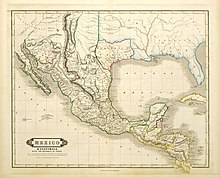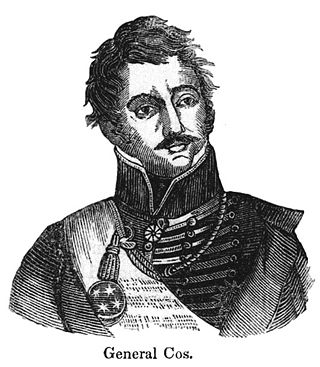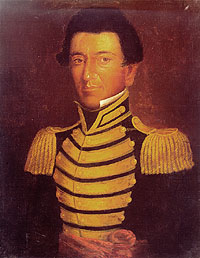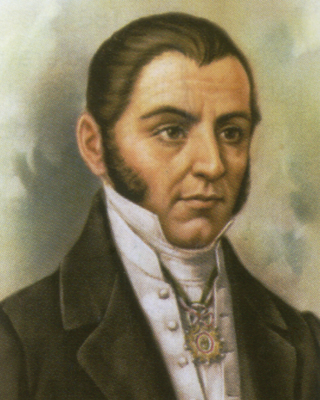| |||||
| Decades: | |||||
|---|---|---|---|---|---|
| See also: | Other events of 1836 List of years in Mexico | ||||

Events in the year 1836 in Mexico.
| |||||
| Decades: | |||||
|---|---|---|---|---|---|
| See also: | Other events of 1836 List of years in Mexico | ||||

Events in the year 1836 in Mexico.

| | This section needs expansion. You can help by adding to it. (April 2011) |

Martín Perfecto de Cos was a Mexican Army general and politician during the mid-19th century. Born in Veracruz, the son of an attorney, he became an army cadet at the age of 20, a Lieutenant in 1821, and a Brigadier General in 1833.

The Battle of San Jacinto, fought on April 21, 1836, in present-day La Porte and Pasadena, Texas, was the final and decisive battle of the Texas Revolution. Led by General Samuel Houston, the Texan Army engaged and defeated General Antonio López de Santa Anna's Mexican army in a fight that lasted just 18 minutes. A detailed, first-hand account of the battle was written by General Houston from the headquarters of the Texan Army in San Jacinto on April 25, 1836. Numerous secondary analyses and interpretations have followed.
This is a timeline of the Texas Revolution, spanning the time from the earliest independence movements of the area of Texas, over the declaration of independence from Spain, up to the secession of the Republic of Texas from Mexico.

The Battle of Coleto, also known as the Battle of Coleto Creek, the Battle of the Prairie, and the Batalla del Encinal del Perdido, was fought on March 19–20, 1836, during the Goliad campaign of the Texas Revolution. In February, General José de Urrea led a branch of the Mexican army up the Gulf Coast of Mexican Texas toward Goliad, where a large contingent of soldiers from the Texian Army was garrisoned under Colonel James W. Fannin. Simultaneously, Mexican president Antonio Lopez de Santa Anna led a larger force into the Texian interior, where on March 6 his troops won the Battle of the Alamo. After learning of the Alamo's defeat, Texian general Sam Houston ordered Fannin to retreat from Goliad and join the rest of the army in Victoria.
Manuel Fernández Castrillón was a major general in the Mexican army of the 19th century. He was a close friend of General and Mexican President Antonio López de Santa Anna. During the Texas Revolution, Castrillón advocated for mercy for captured Texian soldiers. He was killed at the Battle of San Jacinto, despite attempts by Republic of Texas Secretary of War Thomas Rusk to save his life.

Juan Nepomuceno Seguín was a Spanish-Tejano political and military figure of the Texas Revolution who helped to establish the independence of Texas. Numerous places and institutions are named in his honor, including the county seat of Seguin in Guadalupe County, the Juan N. Seguin Memorial Interchange in Houston, Juan Seguin Monument in Seguin, World War II Liberty Ship SS Juan N. Seguin, Seguin High School in Arlington.

José Justo Corro Silva was a Mexican lawyer and statesman who was made president of Mexico on March 2, 1836, after the sudden death of President Miguel Barragán. During his administration, he oversaw the transition from the First Mexican Republic to the Centralist Republic of Mexico and the publication of the new constitution: the Siete Leyes. The nation also faced the ongoing Texas Revolution, and Mexican independence was recognized by Spain and by the Holy See.

José Cosme de Urrea y Elías González or simply José de Urrea was a Mexican general. He fought under General Antonio López de Santa Anna during the Texas Revolution. Urrea's forces were never defeated in battle during the Texas Revolution. His most notable success was that of the Goliad Campaign, in which James Fannin's 400 soldiers were surrounded and induced to capitulate under terms, but were massacred in Urrea's absence on the orders of Santa Anna. Urrea also fought in the Mexican–American War.
Events from the year 1836 in the United States. Exceptionally, this page covers not only the history of the United States, but also that of the Republic of Texas in 1836.

Miguel Francisco Barragán Andrade was a Mexican soldier and politician who served as interim president of Mexico in 1836. He had previously served as Governor of Veracruz, and gained national fame for the capture of the Fortress of San Juan de Ulúa in 1824, through which Spanish military presence was finally expelled from Mexico.
This is a timeline of the Republic of Texas, spanning the time from the Texas Declaration of Independence from Mexico on March 2, 1836, up to the transfer of power to the State of Texas on February 19, 1846.

Events in the year 1835 in Mexico.

Antonio de Padua María Severino López de Santa Anna y Pérez de Lebrón, usually known as Santa Anna or López de Santa Anna, was a Mexican caudillo who served multiple times as president of Mexico. He was a preeminent figure in Mexican politics during the 19th century, to the point that historians of Mexico often refer to three decades after Mexican independence as the "Age of Santa Anna". He has been called an "uncrowned monarch".
Salvador Flores served as a volunteer in the Texan Army in 1835–1836. He was instrumental in organizing and commanding Texian volunteers in support of the Texas Revolution. He participated in many battles and would rise through the ranks to reach Captain status during the fight for Texas independence from Mexico. Salvador continued to provide protection for the ranches and settlers of Texas throughout the Republic years.
Events in the year 1842 in Mexico.
Events in the year 1843 in Mexico.
Plácido Benavides (1810–1837) was an early Mexican-born settler in De Leon's Colony, Victoria County, Texas. Benavides earned himself the sobriquet of the Paul Revere of Texas for his 1836 journey from San Patricio to Goliad to Victoria, warning residents of the approaching Mexican army. He was twice elected alcalde of Victoria, Texas. He married into the powerful De León family, and with his wife Agustina became the father of three daughters. Benavides fought against the dictatorship of Antonio López de Santa Anna, but did not feel Texas should be separated from Mexico.
José Gregorio Esparza, also known as Gregorio Esparza, was the last Texan defender to enter the Alamo during the early days of March 1836 in the Siege of the Alamo and was the only one that was not burned in the pyres. He had brought his family into the Alamo compound along with him. They were able to survive the battle and were not executed by the conquering army.